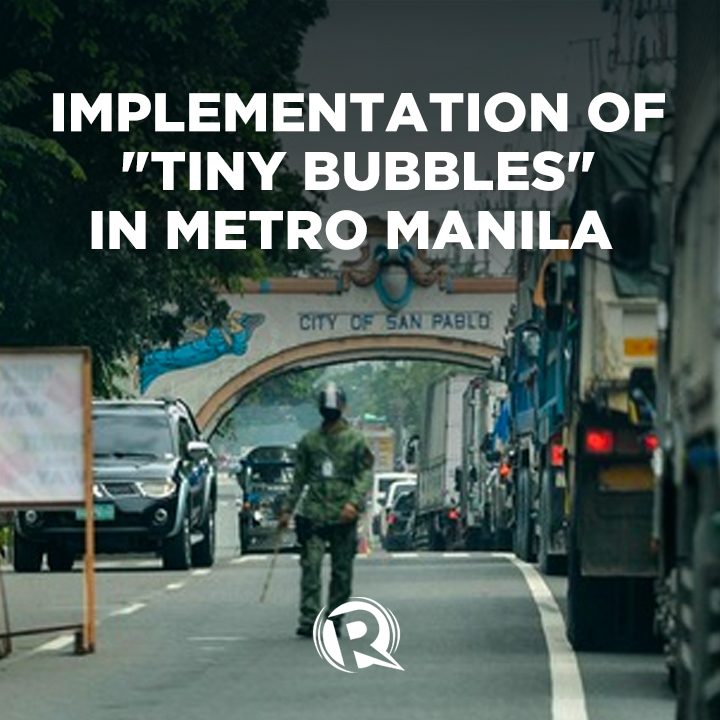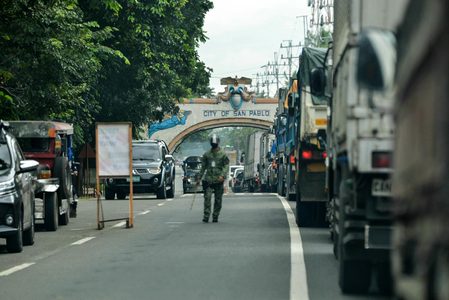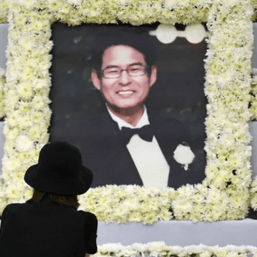SUMMARY
This is AI generated summarization, which may have errors. For context, always refer to the full article.

For the third time, Metro Manila, the Philippines’ capital region, has been placed under the strictest lockdown to curb the surge in COVID-19 cases. Metro Manila mayors announced that curfew from 8 pm to 4 am would be implemented to limit the movement of residents.
While the public transportation would remain operational, the Philippine National Police (PNP) caused confusion after it announced one day that the use of private cars for transporting authorized persons outside of residence (APORs) would be prohibited, and then said the next day it would be allowed but with certain restrictions.
To add to the sense of uncertainty, two days before the implementation of the enhanced community quarantine (ECQ), PNP chief Police General Guillermo Eleazar introduced a concept in relation to movement restrictions: “tiny bubbles.”
The NCR will be under ECQ from August 6 to 20.
What are ‘tiny bubbles’?
According to Eleazar, the “tiny bubbles” rule means that all individual cities and the municipality of Pateros in Metro Manila would each exercise some level of control at their borders.
“From one large bubble” that included Metro Manila and the provinces of Bulacan, Rizal, Laguna, and Cavite, and where cross-border travels were allowed freely the past months, “the NCR (National Capital Region) will shift to tiny bubbles,” the PNP chief said in an interview with DZMM’s Teleradyo on August 4.
That means movement from one city to another within Metro Manila will require the showing of passes or appropriate documents.
Of the old NCR Plus bubble, Metro Manila and Laguna are the only ones left under ECQ.
Who can go in and out of bubbles?

Under the tiny bubbles setup, only working APORs and APORs who need medical attention or scheduled for vaccination would be allowed to cross from one tiny bubble to another.
Consumer APORs would be allowed to go out but only within their respective cities or municipalities. Crossing borders to buy goods would not be allowed, according to Eleazar.
But in the case where an individual lives on the border and the nearby market or store is in the neighboring bubble, the individual will be allowed to cross the border.
“Kung iyon pong pupuntahan naman nila para mag-avail nitong mga essential goods and services is nasa kabila lang and malapit, ina-allow naman po iyon ng ating checkpoint doon,” Eleazar said in a government briefing on August 5. (If the establishments offering the essential goods and services they want to avail themselves of are near their house, even if these are from the other bubble, they would be allowed to cross.)
In a statement on August 9, Eleazar said residents who have other emergencies, such as those whose family members have died, will be considered under the other APORs category.
“Other APORs include our people who have appointments with doctors, and those who have to go home because immediate family members have died, or have a pregnant wife, and other factors that are part of our Filipino culture,” the PNP chief said.
Are there travel restrictions?
Since Metro Manila cities and Pateros are considered as individual bubbles, each will have its own checkpoints.
The police has set up quarantine control points between the borders of the NCR cities and Pateros. These are different from the checkpoints between NCR and the provinces within the NCR Plus bubble.
According to PNP’s Joint Task Force COVID Shield, around 6,800 policemen have been deployed all around Metro Manila. A separate 3,000 cops are deployed to man the borders of the tiny bubbles.

Motorists should expect traffic buildup at checkpoints because the police individually check travelers’ documents.
According to the transportation department, the public transportation will continue to operate during ECQ. However, there will be limitations for tricycles because the interior department is implementing the one passenger per tricycle policy to limit physical interaction.
For non-APORs who would fetch working APORs in the tiny bubbles, the following requirements are needed:
- Certificate of employment for the APOR workers
- Copy of the employer’s business permit
- Certification from the employer, indicating the name, contact number of the driver and employer, and vehicle details
Drivers for other APORs or those who need medical assistance and scheduled for vaccination are allowed. Appropriate documents proving that the driver would transport the APORs are needed at checkpoints.
The PNP chief also said that non-APORs who will fetch OFWs to and from the airport would be allowed by the police during the ECQ. The drivers should present the itinerary and flight details of the OFW as proof.
Eleazar said the police would verify the documents and call respective employers and authorities to verify the authenticity of the documents. If the documents were falsified, the PNP chief said the employer, the driver, or the APOR could face appropriate legal complaints. – Rappler.com
Add a comment
How does this make you feel?





![[The Slingshot] Lito Patay’s 4 hours and 38 minutes of infamy](https://www.rappler.com/tachyon/2024/07/Lito-Patay-4-hours-infamy-July-19-2024.jpg?resize=257%2C257&crop=233px%2C0px%2C720px%2C720px)
There are no comments yet. Add your comment to start the conversation.